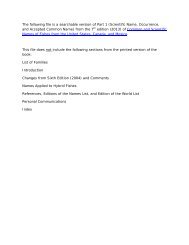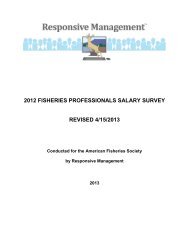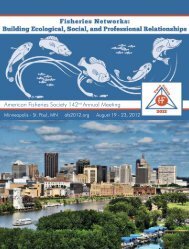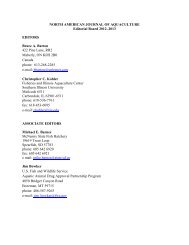Conservation Status of Crayfish Species Paddlefish Conservation ...
Conservation Status of Crayfish Species Paddlefish Conservation ...
Conservation Status of Crayfish Species Paddlefish Conservation ...
You also want an ePaper? Increase the reach of your titles
YUMPU automatically turns print PDFs into web optimized ePapers that Google loves.
OPINION:<br />
FARm BIll<br />
Farm Bill 2007:<br />
Placing Fisheries upstream <strong>of</strong><br />
conservation Provisions<br />
overview<br />
Although policy issues likely cause most<br />
fisheries pr<strong>of</strong>essionals to feel sleepy and<br />
move on to more enticing reading material,<br />
we hope that our colleagues will take the<br />
time to explore the implications <strong>of</strong> upcoming<br />
reauthorization <strong>of</strong> the u.S. Farm Bill.<br />
The name <strong>of</strong> the bill may imply corn and<br />
cattle; however, it is potentially the most<br />
influential aquatic conservation legislation to<br />
be considered by the u.S. federal government<br />
and requires the focused attention <strong>of</strong><br />
all fisheries and aquaculture pr<strong>of</strong>essionals,<br />
especially those within the united States.<br />
Below, we describe the history and inner<br />
workings <strong>of</strong> this legislation and provide a<br />
list <strong>of</strong> issues to be addressed in the 2007<br />
version <strong>of</strong> the Farm Bill. By understanding<br />
this bill, contributing to its genesis, and<br />
fully participating in its implementation as<br />
fisheries scientists, we have the opportunity<br />
to benefit fisheries resources immensely<br />
and create an important precedent for a<br />
future technical presence in the process.<br />
iNtrodUCtioN<br />
The 2002 Farm Security and Rural<br />
Investment Act (i.e., the Farm Bill) is slated<br />
for reauthorization in 2007. This legislation<br />
is vast and complex; the amount <strong>of</strong><br />
fiscal resources appropriated (> $1 billion<br />
annually) by the u.S. congress to conservation<br />
(i.e., promoting the sustainable<br />
use <strong>of</strong> natural resources) within this bill is<br />
considerable and equivalent to or greater<br />
than the conservation budgets within other<br />
resource-oriented agencies (e.g., u.S. Fish<br />
and Wildlife Service). A Farm Bill has existed<br />
in some form since the dust Bowl era when<br />
it provided funding for soil conservation<br />
and implementation <strong>of</strong> improved farming<br />
techniques. In the mid-1980s, Farm Bill provisions<br />
dramatically expanded in scope by<br />
increasing the reach <strong>of</strong> agriculture-related<br />
conservation programs. The 2002 Farm Bill<br />
was even more comprehensive, expanding<br />
incentives for practicing sound conservation<br />
and setting aside land in protected reserves.<br />
Mention <strong>of</strong> aquatic conservation, particularly<br />
as it relates to fisheries, is scarce in<br />
the 2002 Farm Bill language. The linkages<br />
among sound agricultural and forestry<br />
practices, water quality, and aquatic habitat<br />
integrity are implied rather than explicitly<br />
stated. In recent years, the importance <strong>of</strong><br />
land use to aquatic ecosystems, resident<br />
fishes, and other aquatic organisms has<br />
become exceedingly clear (e.g., Naiman<br />
and Turner 2000; Vanni et al. 2005; Hughes<br />
et al. 2006). unlike identifying the effects<br />
<strong>of</strong> point-source pollutants, which can be<br />
directly quantified as water leaves the<br />
pipes, non-point sources such as those<br />
typically associated with farming, ranching,<br />
and forestry are <strong>of</strong>ten difficult to precisely<br />
quantify and relate to aquatic resources.<br />
However, improved geographic-based tools<br />
for assessing land use and other technological<br />
advances such as intensified computer<br />
modeling power have greatly improved our<br />
ability to link land use patterns to aquatic<br />
ecosystems and fisheries at local, regional,<br />
national, and even global scales. Given<br />
recent Internet access to free and easy-touse<br />
geographic-information programs, it<br />
has become very easy for pr<strong>of</strong>essionals and<br />
laypeople alike to envision the complex and<br />
far-reaching relationships between land and<br />
water: a lake, stream, or ocean is always<br />
downhill. For example, seasonal hypoxia in<br />
the Gulf <strong>of</strong> Mexico is now believed to be<br />
a consequence <strong>of</strong> the widespread use <strong>of</strong><br />
nitrogen-based fertilizers in the Mississippi<br />
River basin (Scott et al. 2007). loss <strong>of</strong> fishery<br />
production due to this phenomenon as well<br />
as impacts <strong>of</strong> agriculture-related activities<br />
on other aquatic systems is a major concern<br />
<strong>of</strong> fisheries pr<strong>of</strong>essionals. Riparian disturbance,<br />
and excess nutrients and sediments<br />
are the major stressors <strong>of</strong> 25-30% <strong>of</strong> u.S.<br />
streams, with those percentages increasing<br />
in agricultural regions (Stoddard et al. 2005;<br />
uSepA 2006). The conservation programs<br />
outlined within the next Farm Bill should<br />
provide opportunities by which fisheries<br />
biologists and aquatic scientists can begin<br />
to tackle global and local problems such as<br />
stream channelization, headwater loss, and,<br />
more generally, aquatic habitat degradation.<br />
There are indeed opportunities for<br />
fisheries pr<strong>of</strong>essionals to influence the<br />
direction <strong>of</strong> Farm Bill programs ,as outlined<br />
2007 Farm Bill Advisory<br />
committee <strong>of</strong> the American<br />
Fisheries Society<br />
The committee is chaired by James<br />
e. Garvey, Fisheries and Illinois<br />
Aquaculture center, Southern Illinois<br />
university, carbondale. Garvey can<br />
be contacted at jgarvey@siu.edu.<br />
previously by many authors (pajak et al.<br />
1994; pajak 2000; Thomas et al. 2001). To<br />
do so in the next bill, we should explicitly<br />
outline relationships between land use<br />
(both agricultural and urban) and fisheries.<br />
The Farm Bill is an extremely long and<br />
complicated piece <strong>of</strong> legislation. In this<br />
white paper, we will not review the bill<br />
in its entirety. Throughout the bill, provisions<br />
exist that affect fisheries, such as<br />
funding for land-grant universities where<br />
many fisheries programs reside. We limit<br />
our effort to reviewing some <strong>of</strong> the most<br />
germane programs in the previous Farm<br />
Bill that have had direct implications for<br />
fish conservation and fisheries resources.<br />
We then discuss the pros and cons <strong>of</strong> the<br />
recent u.S. department <strong>of</strong> Agriculture<br />
(uSdA) proposal for the 2007 Farm Bill as it<br />
pertains to fisheries and aquatic ecosystem<br />
condition . We close with some recommendations<br />
for the upcoming legislation and<br />
the participation <strong>of</strong> the fisheries pr<strong>of</strong>ession<br />
in future Farm Bill-related programs.<br />
2002 FArm biLL: A SHort Primer<br />
The 2002 Farm Bill is divided into major<br />
subsections, with the one called “Title II:<br />
conservation and enhancement” being<br />
most germane to fisheries. This section<br />
contains most <strong>of</strong> the major provisions for<br />
conservation, including many well-known<br />
programs such as the Wetlands Reserve<br />
program (WRp) and conservation Reserve<br />
program (cRp). However, other programs<br />
not included in Title II can have indirect<br />
socioeconomic effects on fisheries. To<br />
illustrate, fluctuations in the environment<br />
and markets translate to variable economic<br />
returns in agriculture; government support<br />
is occasionally required to maintain farming<br />
as a viable economic option. Thus, Farm Bill<br />
programs can affect the balance between<br />
farming and other forms <strong>of</strong> land use (e.g.,<br />
urbanization) within many regions, influencing<br />
aquatic condition, human perceptions<br />
<strong>of</strong> natural resources, and behavior <strong>of</strong> the<br />
fishing public. Fisheries science cannot<br />
afford to ignore the indirect effects <strong>of</strong> these<br />
programs on human use <strong>of</strong> the environment,<br />
aquatic resources, and fisheries.<br />
Fisheries • vol 32 no 8 • august 2007 • www.fisheries.org 399







